| Soaring Basics: | ||
|
The following is adapted from an article on the Soaring Association of Canada (SAC) website: Soaring is motorless flight, using a sailplane and natural occurring atmospheric phenomena, called "LIFT", to gain altitude and stay aloft. Lift in the atmosphere occurs in three primary forms. Thermals are by far the most prevalent of lifting sources available to the soaring pilot. They are generated by the heat of the ground radiating upwards to the air directly above. The heated air rises in a vertical column, almost donut shaped, and eventually reaches the condensation level of the airmass, and a cloud is formed. By circling inside this rising mass of air a glider pilot can gain altitude as quickly as 1000 feet per minute, and can reach heights of 8000 feet or more. |
||
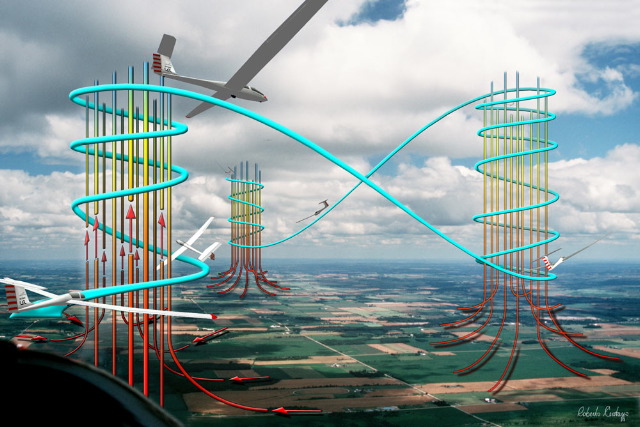
this graphic image is used with the kind permission of Roberto Centazzo |
||
|
Ridge lift is another form of rising air. In this instance a prevailing wind rushes against a long hill or ridge of hills and the air is forced upwards over the hills. If the hills are high enough, and if the run of hills is long enough, great distances can be covered by the sailplane without ever needing to circle in lift. Essentially, once the airspeed required to produce lift for the sailplane wings is produced, the excess airspeed is converted into extra height, or extra forward speed. In North America the best ridge is the Bald Eagle Ridge which goes from Northern Pennsylvania into Tennessee. Distance flights of over 1000km have been recorded along this ridge. Mountain Wave is the third form of lift used in soaring. If a strong wind blows over a row of mountains it may set up a sine wave in the atmosphere, much like water in a river passing over a pebble. The air in a mountain wave can rise or descend as much as 2000 feet per minute, and the phenomenon can exist up to over 50 000 feet of altitude. The current world record for an altitude gain was set in wave, and it surpasses 49 000 feet. Above this height a pressure suit is required. Other types of lift involve cloud flying (prohibited in Canada), flying the edge of a cold front, and using sea breezes to stay aloft and fly large distances. |
||

A cumulonimbus cloud, the epitome of the thermal in its most powerful form. |
 Over the Columbia River, in British Columbia.
Over the Columbia River, in British Columbia.
|
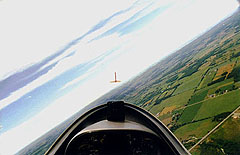
Inside the cockpit, thermalling upwards... |
|
What is a sailplane? What folks refer to as a glider is actually a sailplane. Gliders are usually defined as a motorless aeroplane, and were used extensively in World War Two to transport troops and equipment silently behind enemy lines. A sailplane is always gliding downwards actually, but by using lifting sources which offset the downward speed of the plane, the sailplane can gain altitude and fly great distances without needing to find lift again. Sailplanes vary in terms of construction and size. They have evolved from crude gliders which were open box-kites large enough to carry a person to the enclosed fibreglass resin sailplanes which we see today. In early times flights of 50 kilometres were hailed as a triumph, whereas today a flight of 50km is considered routine. |
||
|
How Do You Get Up There? In the old days we used winches or bungees to launch gliders and sailplanes off the sides of a hill. Today we still use winches but aerotows are more common. A small powered aircraft tows the sailplane upwards using a 200' long polypropylene rope, about 3/8" thick. Once the planes reach 2000' (the common height for release) the sailplane releases the rope and begins what is generally referred to as "free flight". |
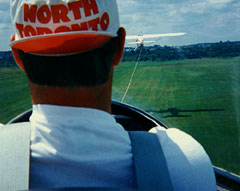 |
|
|
How Do You Get Down? Landing an aeroplane with power is similar to landing a pure glider, but there are significant differences, and in soaring you only get one shot at it!! Most pilots use a circuit to align themselves with the runway they want to land on. They fly parallel to the runway (downwind leg), then turn across the end (base leg), and then turn final and begin their approach. As the sailplane is already descending the pilot only has to modify his decent rate using dive brakes or spoilers. The pilot has to correct for drift due to cross-winds and once done the pilot will flare the plane and then touch down onto the runway. Momentum ensures that the plane rolls evenly on its mainwheel. Only when the plane stops rolling does a wing gently touch the ground. |
||
|
The "Big Parts" of a Sailplane Below are 3-view drawings of a modern sailplane. Although somewhat simplified, the drawings show the basic structure of a typical sailplane for the 15 metre class. There are many different racing classes of gliders, Standard Class (15m span, no flaps), 15 Metre Class (15m span with flaps), Open Class (Large metre spans, ranging from 15m to 25m and over), and the new World Class which uses the PW-5 sailplane exclusively. |
||


 |
||
|
Instruments Instrumentation on each sailplane varies according to pilot preference, but each carries a minimum of altimeter, airspeed indicator, a magnetic compass, a variometer (a sensitive vertical speed indicator), and the "yaw string". Most pilots immediately upgrade their factory "vario" for a total energy system. Simply put, the total energy system allows the pilot to get a more accurate reading on the lift or sink surrounding the sailplane, but does not take into account "stick lift" or a vertical acceleration by the pilot like an uncompensated vario would. The most useful instrument by far is the yaw string. Attached to the outside of the canopy at one end, this 3 inch piece of red yarn shows the pilot the relative airflow of the glider. It works opposite to the more common "ball" found in powered aircraft. Glider pilots try to keep the plane co-ordinated at all times, but with large wings and ailerons on the planes, adverse yaw is a factor to be reckoned with. Glider pilots are forced to use the rudder pedals all the time to get the most from their plane. Of course, the most important instrument for all pilots remains on our body, the eyeball. If you would like to read more about gliders, visit the SAC Supplies page, there are many book titles to choose from. |
||
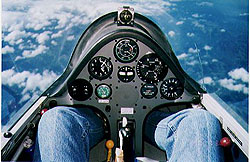 |
|
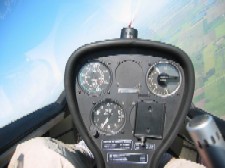 |
|
Where do I learn? In Canada almost all training takes place at gliding clubs. Instruction is usually free of charge, a student only pays for launches and rental of the glider. However, belonging to a club means paying a membership fee. Included in this fee is your SAC dues, which provides the pilot with third party liability insurance lest they land on something, or someone, and cause damage. Also, SAC provides a high quality magazine called free flight which is published once every two months and mailed to all members. Clubs vary in size and structure, but everyone goes to the gliding club for the same reason; to fly. After taking an introductory flight you may decide to pursue your lessons in earnest. Check our SSC webpage on Becoming a Glider Pilot for more information on the steps involved in attaining your license through the Saskatoon Soaring Club. |
||
|
|||
